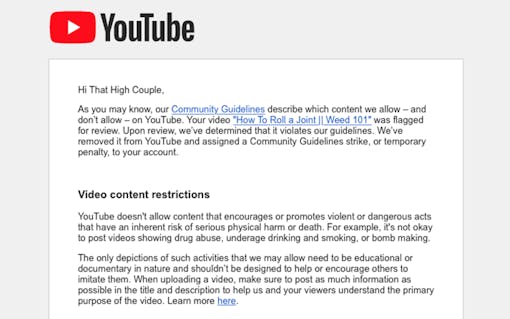A few weeks ago, Sam Houston, a California cannabis aficionado, was checking out some of his favorite YouTube channels when he noticed a trend. One by one, accounts such as those run by users “Vader OG” and the horticulturalist known as Jorge Cervantes were being shut down. All were given the same ominous message: The channel’s content had been flagged for review and was found to violate YouTube’s guidelines.
For the last month, the global video platform has been shutting down a wide swath of cannabis channels, often with little or no warning.
Houston, who works as a community manager in San Francisco, was perplexed. Those channels have been around for a long time. Some were showing or discussing cannabis growing techniques or sharing the trials and tribulations of growing the plant. Most were merely informational videos, not sexually explicit or dangerous in any way.
Houston wasn’t alone. His frustration has been felt across the entire community of cannabis YouTube content creators. For the last month, the global video platform has been shutting down a wide swath of cannabis channels, often with little or no warning. Two years ago, Facebook famously shut down many cannabis-related accounts, but YouTube has always been much friendlier and more tolerant of cannabis material.
The move, which came with no public notice from YouTube, has the cannabis world confounded. It comes as an abrupt about-face at a time when cannabis is gaining wider social acceptance. The plant remains federally illegal, but only a small handful of states outlaw it in all forms.

Goodbye, years of hard work and thousands of subscribers.
YouTube’s Warning Flags
Dylan Osborn is the founder of Greenbox Grown. It’s a site and channel aimed at teaching people how to grow their own medicine “without spending too much money or without too much time or effort,” he told Leafly. YouTube flagged the channel a few weeks ago.
That channel boasted 13,000 subscribers and more than 200 videos. Many of them were instructional how-to videos, along with strain reviews. Several months ago Osborn started getting flagged, the “sixth time in the last four months,” he estimated. But he’d always be reinstated with a quick email.
This time, though, it wasn’t just his channel. “You could tell it was different,” he said. “Lots of other channels were getting taken down, channels that had been around for years and years.”
Why Cannabis? Why Now?
Osborn expressed frustration at the inability to figure out how exactly he was suddenly violating the channel’s rules. “There are tons of other videos violating content guidelines that aren’t cannabis related,” he said. “You can watch videos about how to make bombs out of household items on YouTube all day.”
Osborn has since switched to self-hosting his videos and charging a $14.99 monthly subscription fee.
First Guns, Now Cannabis
The ban on some cannabis content echoes the recent shutdown of channels showing gun videos. Many who had gun content turned to self hosting or moved their videos to Pornhub (which went on to implement its own ban). Some cannabis content creators are now moving their material to Instagram and other social networking sites.
In April, YouTube was quoted by New York magazine as having changed its policies. A YouTube rep said in a statement: “While we’ve long prohibited the sale of firearms, we recently notified creators of updates we will be making around content promoting the sale or manufacture of firearms and their accessories.”
Now, it seems, YouTube is taking a similar approach to cannabis—with a liberal interpretation of what might constitute the “promotion” of cannabis.
Maybe It’s the Ad Money
Clark and Alice are video bloggers from Hollywood, California. They post to YouTube as “That High Couple.” They too have been abruptly deleted, losing 28,000-plus subscribers.

“We’ve determined that it violates our guidelines.” That High Couple received the YouTube video death penalty for their content, and found no way to appeal the decision.
“YouTube’s reason for suspending our channel was that we ‘broke community guidelines,’” they told Leafly in an email. “There was no specific reason, only a generic list that it could be because we were promoting violence, illegal drug use, creating spam content, etc.”
They surmise that the reason behind the shutdown is advertising money. “YouTube can’t make ad revenue from cannabis content,” they wrote. “Last year, YouTube went through what most are calling ‘The Adpocalypse,’ where many top advertisers were seeing their ads play before content that was inappropriate and damaging to their brand. Once the money started leaving, YouTube updated their algorithm to prevent ‘unsuitable’ content from getting ads delivered against their content and the whole system has been crumbling ever since.”
But Alex Jones Is Okay?
YouTube has come under scrutiny for allowing questionably appropriate content for children. Most recently, the platform has come under fire for allowing videos by conspiracy theorist Alex Jones attacking Sandy Hook survivors and claiming that the mass shooting of schoolchildren “didn’t happen.” Meanwhile, YouTube removed a video report by Media Matters showing how Jones spread falsehoods. (It was later reinstated.) YouTube also took harsh criticism for its handling of the Logan Paul controversy, in which the YouTube star exhibited the body of a person who had hanged himself in a Japanese forest.
“Advertisers again pressured YouTube to monitor their content, and many channels with ‘questionable’ content have been getting terminated as a result,” Alice and Clark wrote in their email.
No More Warning Strikes
Another channel creator, Kord Tagley, also had his channel shut down last month. Tagley’s channel, GreenGenes Garden, offered mostly informational material, such as programming about grow lights and other technology. The channel began six years ago as a marketing tool for Tagley’s business, Pacific Light Concepts, which sells LED lights.
Kord Tagley felt he did everything he needed to be compliant with California state guidelines on advertising. But that didn't stop YouTube from ending his channel.
YouTube’s sudden denunciation of cannabis content is puzzling to Tagley. He felt he did everything he needed to be compliant with California state guidelines on advertising, such as including age-appropriate (21+) warnings before the start of his videos. He became part of the Google Adsense partnership program once he crossed 10,000 subscribers a few years ago (he had 43,000 when he was shut down) and had amassed about 7 million total video views.
Tagley was making a tiny profit from his YouTube videos, he said, but that’s not what upsets him. In addition to the loss of viewership—once YouTube makes a channel a partner, the platform boosts its views—YouTube bypassed its usual three-strike warning protocol before deleting his account.
After the first strike, “you can no longer livestream for the next 90 days,” he said. “Two strikes, you can’t upload any more content, and three strikes, they’ll delete your account.”
He’d received a few strikes for five-year-old videos, appealed, and won—and the strikes were rescinded. After receiving emails from the Russian government “saying that they were going to ban some of my videos in their country and that Google may have to act accordingly,” he said, “I received emails from Google or YouTube saying that there had been one or more legal complaints and that they had to act and delete my account.” He’d struck out.
As an alternative, he’s now airing his daily videos on TheWeedTube.com, a community-created, cannabis-focused video site.
Moving to Instagram or Pornhub
Several other channel creators reappeared on Instagram. There, they directed followers to other sites, including gaming platform Twitch, which recently opened up to allow cannabis content for livestreaming. Users are also creating new YouTube accounts to reach their old subscribers. After one video was flagged, YouTuber “Vader OG” made a second one—which was flagged as well. “YouTube went ahead and gave me two strikes,” he says in a video on a second channel, which he dubbed his “lifeboat.”
“The first strike was two videos. It was just kind of weird, but I kept uploading, of course, and bam, I got a second strike,” he continues. “So I am unable to upload for at least two weeks, which kind of gets in the way of the daily series.”
Others, have followed the approach of some gun channel creators, shifting to a site with a high tolerance for adult content: Pornhub.
Osborn has been in contact with other YouTube channel creators about next steps. “We are all trying to figure this out together,” he said.
Nobody Can Reach YouTube
YouTube’s motives are equally unclear to the channel creators. Communication is hard, if not impossible. “YouTube only gives you 500 characters, so that’s spaces included, to appeal any of their strikes,” Tagley says. “It appears that bots are reviewing the appeals, because they’re getting bounced back in a matter of minutes.”
Messages left with YouTube’s media contacts were not immediately returned.
Osborne and the other video creators are frustrated by the lack of communication. “It’s unfortunate they are not working with us on this issue,” Osborn said. “They are just shutting the door and that’s it.”
Update: On April 25, That High Couple had their YouTube channel restored. Leafly and That High Couple are still waiting on an explanation for the original shutdown and the restoration.





